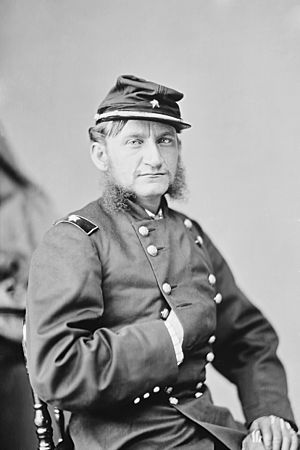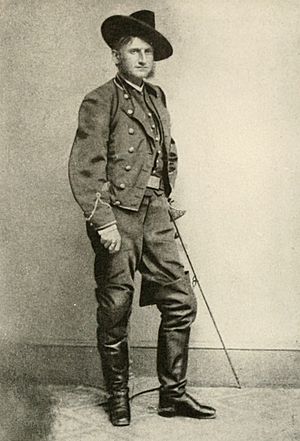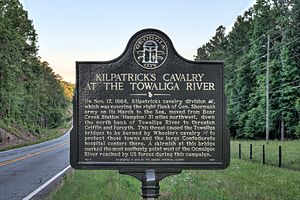Hugh Judson Kilpatrick facts for kids
Quick facts for kids
Hugh Judson Kilpatrick
|
|
|---|---|

Brig. Gen. Judson Kilpatrick between circa 1863 and circa 1865
|
|
| United States Minister to Chile | |
| In office July 25, 1881 – December 4, 1881 |
|
| President | James Garfield Chester Arthur |
| Preceded by | Thomas A. Osborn |
| Succeeded by | Cornelius Ambrose Logan |
| In office March 12, 1866 – August 3, 1870 |
|
| President | Andrew Johnson Ulysses S. Grant |
| Preceded by | Thomas H. Nelson |
| Succeeded by | Joseph Pomeroy Root |
| Personal details | |
| Born | January 14, 1836 Wantage Township, near Deckertown, New Jersey (now Sussex Borough) |
| Died | December 4, 1881 (aged 45) Santiago, Chile |
| Political party | Republican |
| Military service | |
| Allegiance | United States of America Union |
| Branch/service | United States Army Union Army |
| Years of service | 1861–1865 |
| Rank | |
| Battles/wars | American Civil War |
Hugh Judson Kilpatrick (born January 14, 1836 – died December 4, 1881) was an important officer in the Union Army during the American Civil War. He reached the high rank of major general. After the war, he served as the United States Minister to Chile. He also tried to become a member of the U.S. House of Representatives, but was not successful.
Kilpatrick was known for his very bold and aggressive tactics in battle. Some people called him "Kilcavalry" because of his daring approach to leading cavalry charges. He was praised for his victories, but also disliked by some Southerners because his actions sometimes caused a lot of damage to their homes and towns.
Contents
Early Life and Military Start
Hugh Judson Kilpatrick, often called Judson Kilpatrick, was born on January 14, 1836. He was the fourth child of Colonel Simon Kilpatrick and Julia Wickham. His family lived on a farm in Wantage Township, near Deckertown, New Jersey.
Kilpatrick studied at the United States Military Academy and graduated in 1861. This was right after the American Civil War began. He started as a second lieutenant in the 1st U.S. Artillery. Very quickly, within three days, he became a captain in the 5th New York Infantry.
Kilpatrick was the first officer in the United States Army to be wounded in the Civil War. He was hit in the leg during the Battle of Big Bethel on June 10, 1861. By September 25, he was a lieutenant colonel in the 2nd New York Cavalry Regiment. He helped create this regiment, and it was with the cavalry that he became well-known.
Civil War Service
At first, Kilpatrick's assignments were not very active. He worked in staff roles and took part in small cavalry fights. This changed during the Second Battle of Bull Run in August 1862. He led a raid on the Virginia Central Railroad and later ordered a cavalry charge that cost his unit many soldiers. Despite this, he was promoted to full colonel on December 6.
Kilpatrick was a very aggressive and fearless leader. He was also ambitious and good at using his political connections to advance his career. His soldiers often called him "Kill Cavalry" because he was willing to push his men and horses very hard in battle. Cavalry's main roles during this time were scouting, raiding, and gathering information.
In February 1863, Maj. Gen. Joseph Hooker formed a special Cavalry Corps in the Army of the Potomac. Kilpatrick was given command of the 1st Brigade, 2nd Division. During the Chancellorsville Campaign in May, his cavalry was ordered to go behind Gen. Robert E. Lee's army. Their goal was to destroy railroads and supplies. Kilpatrick did this with great energy. He captured wagons, burned bridges, and rode almost to the edge of Richmond, Virginia. This daring action was part of Stoneman's 1863 Raid.
Gettysburg Campaign Actions
The Gettysburg Campaign began with the Battle of Brandy Station on June 9, 1863. This was the largest cavalry battle of the war. Kilpatrick was promoted to brigadier general on June 13, at just 27 years old. He also fought in the battles of Aldie and Upperville. Three days before the Battle of Gettysburg, he took command of a division.
On June 30, Kilpatrick's cavalry had a brief fight with J.E.B. Stuart's cavalry at Hanover, Pennsylvania. However, instead of focusing on gathering information, Kilpatrick chased after Stuart.
On July 2, 1863, the second day of the Gettysburg battle, Kilpatrick's division fought against Wade Hampton at Hunterstown. On July 3, after Pickett's Charge, Kilpatrick was ordered to lead a cavalry charge against Confederate infantry. One of his commanders, Brig. Gen. Elon J. Farnsworth, thought the attack was pointless. Kilpatrick insisted on the charge, and Farnsworth sadly followed the order. Farnsworth was killed in the attack, and his unit suffered many losses.
Kilpatrick and the rest of the cavalry chased and bothered Lee's army as it retreated back to Virginia. Later that fall, he took part in a mission to destroy Confederate gunboats on the Rappahannock River. He successfully boarded the boats and captured their crews.
Richmond Raid and Western Transfer
In the spring of 1864, Kilpatrick led a raid towards Richmond, Virginia. He hoped to free Union prisoners held there. On February 28, his division moved past Robert E. Lee's army and headed south. By March 1, they were very close to Richmond. However, the city's defenses were too strong. Confederate soldiers and local militias constantly attacked them.
Kilpatrick decided to move his forces towards Fort Monroe, where Ben Butler's Army of the James was located. The raid caused a lot of damage around Richmond. Kilpatrick's men destroyed tobacco barns, boats, railroad tracks, and other important structures. They also left pamphlets offering forgiveness to Southern civilians who promised loyalty to the United States.
After this difficult expedition, Kilpatrick was transferred to the Western Theater of the war. He took command of the 3rd Division of the Cavalry Corps under Maj. Gen. William Tecumseh Sherman.
Campaigns in Georgia and the Carolinas
Starting in May 1864, Kilpatrick rode with Sherman in the Atlanta Campaign. On May 13, he was badly wounded in the leg at the Battle of Resaca. His injury kept him out of action until late July. He was very successful at raiding behind Confederate lines, tearing up railroads. At one point, his division rode completely around the enemy positions in Atlanta. His unit also played a key role in the Battle of Jonesborough on August 31, 1864.
Kilpatrick continued with Sherman through his famous March to the Sea to Savannah. Then he moved north in the Carolinas Campaign. He enjoyed destroying Southern property. During the Battle of Monroe's Crossroads, he was surprised by Confederate cavalry and had to quickly escape. Kilpatrick later fought with troops under Joseph Wheeler at the Battle of Aiken in Aiken, but he lost the battle and had to retreat.
Kilpatrick was with Maj. Gen. William T. Sherman during the surrender talks at Bennett Place near Durham, North Carolina, on April 17, 1865.
After the war, Kilpatrick commanded a cavalry division from April to June 1865. He was promoted to major general of volunteers on June 18, 1865. He left the Army on December 1, 1865.
Later Life and Diplomacy
After the war, Kilpatrick became involved in politics as a Republican. In 1880, he ran for the U.S. Congress from New Jersey but did not win.
In November 1865, President Andrew Johnson appointed Kilpatrick as the United States Minister to Chile. He continued in this role under President Grant.
As the American Minister to Chile, Kilpatrick tried to help make peace during the Chincha Islands War. This war involved Spain and several South American countries. After the Valparaiso bombardment in 1866, Kilpatrick asked the American naval commander, Commander John Rodgers, to defend the port. The Spanish admiral, Méndez Núñez, famously said, "Spain prefers honor without ships to ships without honor." This meant he would rather lose his ships than give up his country's honor.
Kilpatrick was called back from Chile in 1870. His appointment to Chile in 1865 was partly due to a political agreement. He had supported Marcus Lawrence Ward for governor of New Jersey, and in return, he received the diplomatic post.
In Chile, he married his second wife, Luisa Fernandez de Valdivieso. She came from a wealthy family. They had two daughters: Julia Mercedes Kilpatrick (born November 6, 1867, in Santiago, Chile) and Laura Delphine Kilpatrick (1874–1956).
In March 1881, President James Garfield again appointed Kilpatrick as Minister to Chile. This was to recognize his service to the Republican Party in New Jersey. Kilpatrick died shortly after arriving in the Chilean capital, Santiago. His body was brought back to the United States in 1887 and buried at the West Point Cemetery in West Point, New York.
Kilpatrick also wrote two plays: Allatoona: An Historical and Military Drama in Five Acts (1875) and The Blue and the Gray: Or, War is Hell (published after his death in 1930).
Legacy
Battery Kilpatrick at Fort Sherman, located at the Atlantic end of the Panama Canal, was named in honor of Judson Kilpatrick.
The World War II Liberty Ship SS Hugh J. Kilpatrick was also named after him.
The Major General Judson Kilpatrick Camp No. 7, Sons of Union Veterans of the Civil War, was formed in September 2021 in Cary, North Carolina. This group was named to honor the general.
See also
 In Spanish: Hugh Judson Kilpatrick para niños
In Spanish: Hugh Judson Kilpatrick para niños
- Battle of Gettysburg, Third Day cavalry battles
- List of American Civil War generals (Union)




